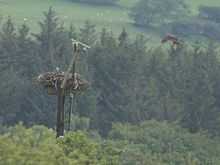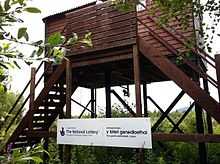Dyfi Osprey Project


The Dyfi Osprey Project is located at the Cors Dyfi nature reserve near Derwenlas, in the county of Powys, Wales and is under the management of the Montgomeryshire Wildlife Trust.[1]
History and activity
2011
In 2011, for the first time in over 400 years Ospreys are breeding in the Dyfi valley on the Cors Dyfi Nature Reserve site,[2] following three years work by the trust to reintroduce the birds into the area.
A resident male osprey managed to attract a female osprey (a 2008 bird from a Rutland Water nest) who laid their first egg on 25 April 2011, a second three days later and a final egg on 1 May 2011.
On 5 June 2011 the first osprey chick emerged, the second on Monday 6 June 2011 and the third on 7 June 2011, comprising one female (ringed Blue DJ) and two males (ringed Blue DH and Blue 99). The young ospreys are named after local rivers that flow into the River Dyfi; The female, Leri; and the two males Einion and Dulas.[1]
Satellite tracking
The Montgomeryshire Wildlife Trust, working in partnership with the BBC (since featuring the Dyfi Osprey Project on Springwatch in 2011) successfully fitted all three of the osprey chicks with GPS satellite trackers as they were ringed on 19 July 2011 to feed back positional information on their 3,500 miles (5,600 km) migration to Africa.[3] These are the first Welsh ospreys to be satellite tracked.[4]
2012
In 2012, the same two adult ospreys (Monty and Nora) returned from migration to the same nest site at Cors Dyfi. Nora arrived on 24 March, and Monty returned on 2 April.
The first egg was laid on Wednesday 18 April, and subsequent eggs laid at three day intervals on 21 and 24 April respectively. Forty days after being laid, the first egg hatched on Monday 28 May. However this chick was only to survive for three days. Meanwhile the other two eggs had also hatched.
However, a persistent period of torrential rain and cold weather then hit west Wales, flooding the marsh area where the nest is located. On Saturday 9 June the smallest chick also perished, and the last remaining chick was also becoming weaker.[5] Normally it would not be the policy of a wildlife project to intervene with nature, however in the interests of re-establishing osprey populations in Wales, the project decided to act. There followed the most amazing rescue operation by the staff of the Dyfi Osprey Project. Two members of DOP waded through deep water out to the nest with ladders, and removed the chick from the nest, dried its feathers, warmed it up and fed it some tiny pieces of fish, before carefully returning it to the nest around thirty minutes later. The little chick rallied! Three days later it was named Ceulan, after the local river Ceulan which had burst its banks during the rains.
On Friday 13 July, the chick - now a juvenile - was again removed from the nest, this time for ringing with a Blue darvic ring with the letters 3C, and was weighed and measured with the verdict that Ceulan was a young male. A satellite tracker was also fitted so that he could be followed as he made his first migratory journey. Just over a week later, he fledged from the nest at 53 days old, and after some flying practice over the next few weeks, he departed on 3 September. His mother, Nora had already left on migration, leaving Monty to continue to feed the youngster. Monty departed just two days after Ceulan.
Ceulan was then followed on his journey south through Europe and across into Africa, where he ended up in Senegal. On 1 December, Ceulan dived into Diawel River, a tributary of the Senegal River and got caught up in some fishing nets and was unable to get free. He was found the following morning by a local fisherman, who realised with the tracker that this was an important bird and kept him for two weeks. When local birdwatchers came in search of Ceulan, they were taken to the fisherman and retrieved his body on 15 December 2012.
2013
In 2013, the first osprey to visit the nest on 5 April was a new female bird, named Elin. The resident male, Monty, returned on Sunday 7 April, by which time Elin had disappeared again, to reappear briefly on 19 April. Nora, the breeding female from 2011 and 2012 was not to return that year.
On 23 April, a second female appeared, she was unringed, and given the name Seren (Welsh for star). She mated with Monty and stayed three days, but then also continued on her journey. The next day a third female, ringed BlueFS, arrived on the nest. This was a three-year-old female who had hatched in Dores near Loch Ness, Scotland. She ate a lot of fish but refused to mate with Monty.
On Monday 29 April at 10.30am a fourth bird White UR (a 3 year old bird who hatched at Ythan Valley, Aberdeenshire) was seen on a nearby perch. Shortly after Seren reappeared, divebombing BlueFS on the nest, ousting her and taking possession - BlueFS was not seen again. On Tuesday 30 April a fifth female bird appeared - Blue12, a three-year-old who had hatched at Rutland[6] and had briefly visited Cors Dyfi in 2012, landing on the nest briefly and surprising the young Ceulan. Monty set off in chase after Blue12, and an aerial battle lasting 7 hours ensued. The chase continued on 1 and 2 May. Meanwhile a bored Seren disappeared again on 2 May and was not seen again.
On 3 May a victorious Blue12 landed on the nest. Monty arrived and dropped a fish on her back. Four days later, Blue12 was named Glesni, which is Welsh for blue/blueness after her Darvic ring colour.
The first eggs were laid on 22 and 25 May, and were to hatch successfully on 28 and 30 June, despite fears that one would not after it was pecked by a crow and appeared to have a tiny chip.
On 6 August the two chicks, both females, were ringed and named - Clarach (Blue/white 2R) and Cerist (Blue/white 1R), and they fledged on 18 and 20 August respectively. Cerist disappeared for two days after fledging, with fears for her safety, but she returned safely on 22 August.
On 31 August, Glesni left on migration. Monty continued to feed his two offspring. Clarach migrated on 18 September and Cerist on 20 September, both aged 82 days. Monty departed less than an hour after Cerist.
2014
In 2014, the first bird to visit Dyfi was on 24 March, when a four-year-old female from Rutland Water ringed Blue24 arrived. She had also been seen briefly in both Dyfi and Rutland in 2013, but had then spent summer 2013 on a nest in Gwynedd.
On 2 April, a local unringed male bird known as Dai Dot (because of his two white eyebrow feathers) arrived on the nest, but Blue24 had been seen the day before back in her natal site in Rutland. The next day she returned and they mated, building the nest together.
The resident male osprey arrived on 8 April, chasing Dai Dot down the Dyfi Estuary. Blue24 remained on the nest, and Monty brought her fish and mated with her. On 10 April, the 2013 female, Glesni (Blue12) returned, and a major skirmish between the two females began, lasting several days, with Glesni eventually reclaiming her nest, despite major divebombing by Blue24. Blue 24 was to return several times over the next weeks, including landing on a nearby unused nest platform.
The first egg was laid on 2 May, and the second on 6 May. Despite further intrusions on the nest by Blue 24 during incubation, both eggs successfully hatched on 8 and 11 June. The chicks were ringed aged 37 days and 34 days, and judged to be a young male, name Gwynant (Welsh for White stream, due to the very white egg from which he hatched and his lighter plumage) and Deri (a tributary of the Dyfi) - blue and white Darvic rings as well as BTO rings were placed on the birds - Gwynant carries Darvic ring Blue/white 3R and Deri 5R.[7] Neither chick was satellite tagged. Gwynant fledged the nest aged 49 days on 27 July, and Deri at 51 days on 1 August.
The female, Glesni, was again first to leave on migration on 19 August. The two chicks followed, with Gwynant departing on 30 August and Deri on 4 Sept. The male, Monty started his migration on 7 September.
The new Cors Dyfi 360º Observatory
On 18 April 2014, Montgomeryshire Wildlife Trust opened a brand new, three floor £1.4m observatory on the Cors Dyfi Reserve.[8] From the upper viewing level, 10 m (33 ft) above the bog below, the building provides a full 360 degree panoramic view of the Cors Dyfi Reserve and Dyfi Valley with the Plynlimon Mountains and Snowdonia National Park beyond, enhancing the visitor experience to the full range of flora and fauna on the reserve.[9] The two main sources of funding for the Observatory were The Heritage Lottery Fund and European Regional Development Fund Communities and Nature project. In-kind volunteering support and a grant from the Countryside Council for Wales also contributed to its successful construction.
In February 2015, it was announced that the Cors Dyfi 360 Observatory had been shortlisted in the RICS Wales Awards, which recognise inspirational developments in land management, property, & construction.[10]
Ospreys in Wales: The First 10 Years
At the end of 2014, a book Ospreys in Wales: The First 10 Years[11] was published by Dyfi's Project Manager Emyr Evans, with photography by Andy Rouse and the author himself, and a forward by Iolo Williams. The book offers a detailed photographic record and personal history of osprey re-establishment in the country. It focuses particularly on the Glaslyn Osprey Project near Porthmadog, where birds have been nesting successfully since 2004, and the Dyfi Osprey Project.
Dyfi Ospreys on BBC Springwatch & Autumnwatch
In 2011, the Montgomeryshire Wildlife Trust teamed up with BBC Springwatch and Autumnwatch to feature the Dyfi ospreys.[12] The first show was broadcast on 7 October 2011 and a series of clips followed the birds on migration, presented by leading conservationist Roy Dennis, who travelled to West Africa where they finally tracked down the satellite tagged chick Einion (BlueDH).[13][14]
In 2012, BBC Springwatch was being broadcast from nearby Ynys-hir RSPB reserve during torrential rain, flooding the valley, the BBC's own camp and the nest area, resulting in a rescue of one chick, Ceulan.
In 2013, BBC Springwatch returned again to Cors Dyfi, and filmed the battles between the female birds to win the nest, after the previous two years' female, Nora did not return.[15] In 2014, the programme moved to a new location at RSPB Minsmere, but still followed activity at DOP, broadcasting footage of the battle between Glesni Blue 12 and her cousin Blue 24, which had been taken from the HD cameras at the Dyfi Osprey Project itself.
See also
- The Montgomeryshire Wildlife Trust
- Cors Dyfi nature reserve
- Ynys-hir RSPB reserve
- Glaslyn Osprey Project
- Ospreys in Britain
References
- ↑ 1.0 1.1 Wildlife Trust
- ↑ BBC - Dyfi estuary Ospreys
- ↑ BBC - Dyfi estuary ospreys chicks have satellite trackers
- ↑ Osprey Interactive Tracker
- ↑ http://www.bbc.co.uk/news/uk-wales-mid-wales-18406833
- ↑ http://www.dyfiospreyproject.com/blog/2013/05/nora-glesni-and-the-rutland-legacy
- ↑ http://www.dyfiospreyproject.com/blog/2014/07/ringing-day-2014
- ↑ http://www.bbc.co.uk/news/uk-wales-mid-wales-27407522
- ↑ http://www.dyfiospreyproject.com/blog/2012/09/360-observatory
- ↑ http://www.countytimes.co.uk/news/144792/cors-dyfi-nature-reserve-shortlisted-for-national-award.aspx
- ↑ ISBN 978 0 9930990 0 7
- ↑ http://www.bbc.co.uk/nature/life/Osprey
- ↑ http://www.bbc.co.uk/programmes/p00kslyb
- ↑ http://www.dyfiospreyproject.com/autumnwatch
- ↑ http://www.bbc.co.uk/news/uk-wales-mid-wales-22125997